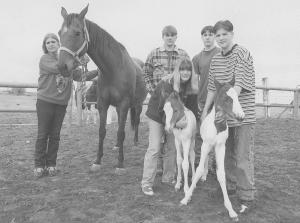2000 - Volume #24, Issue #2, Page #21
[ Sample Stories From This Issue | List of All Stories In This Issue | Print this story
| Read this issue]
Twins Ar The Rule For Horses And Humans On This Farm
 |
Twins are considered rare in horses but for some uncanny reason, Hobson's operation gets far more than its share. In past years, she has always had at least one or two mares out of 10 conceive twins.
"Just this year, out of 25 mares bred, 10 of them conceived twins. Most commonly, what happens is that the mare will abort them, but we don't want that to happen because then you end up running an open mare," Hobson explains. "Instead, we have our vet do a rectal ultrasound at 17 days and again at 21 days to determine if twins exist. If they do, he pinches off the smallest one - it's like pinching off a grape - and the mare's body absorbs it."
Then, a week later, Hobson's vet comes back and does a third ultrasound to make sure that the remaining embryo wasn't disturbed. What makes Hobson's story even more unusual is that she's had her own two sets of twins (Shane and Seth, 21, and Stefanie and Steven, 17). She wouldn't change a thing as far as her family, but when it comes to horses she'd rather not have twin foals.
"It's just too hard. The babies come out too small, so they're weak and need a lot of extra attention. We don't even apply for breed registration papers for twins because they take a long time to mature, are usually stunted, and are of poorer quality than if they had been single foals. We give them away to 4-H kids instead," she explains.
The live twin foals that have been born on the Hobson ranch were ones that somehow slipped through the screening process and most weighed 35 to 40 lbs. at birth.
Many of Hobson's registered Paints are half Thoroughbred and it is thought by many that Thoroughbreds are more likely to conceive twins.
However, equine veterinarian Carol Shwetz of Westlock, Alberta, Canada, says this could easily be a misconception because Thoroughbreds are also the horses that receive the most ultrasound examinations, due to their high value.
"It's possible that other breeds conceive just as many twins, but we just don't find out about them because they are re-absorbed or aborted," she says. "Belgians have the highest success rate in producing live twins, but it is still rare."
Shwetz quoted the following statistics from one of her veterinary reference books:
Out of every 1,000 bred mares that ovulate and conceive, 160 will conceive two eggs
150 of those (95 per cent) will lose or re-absorb those embryos at 40 to 45 days (before implantation)
Of the 10 remaining, six or seven will abort both foals or deliver them dead
Two or three will deliver one live foal
One will produce viable twins
Shwetz has no explanation for the high rate of twinning on the Hobson farm but says the trait can be genetic and that having a number of horses with similar bloodlines may increase the chances of twins.
But, of course, that doesn't explain why Hobson herself also had two sets of twins.
"Yeah, it's really strange why we've had so many twins on our ranch. It's something we don't understand, but we have a standing joke when people come to visit us," Hobson says. "We tell them, æDon't drink the water'."
Contact: FARM SHOW Followup, Shawna Hobson, Hobson's Paint Horses, 16393 Road 1 NW, Quincy, Wash. 98848 (ph 509 785-6731; E-mail: shobson@ televar.com; Website: www.geocities.com/shobson_99).

Click here to download page story appeared in.

Click here to read entire issue
To read the rest of this story, download this issue below or click here to register with your account number.




